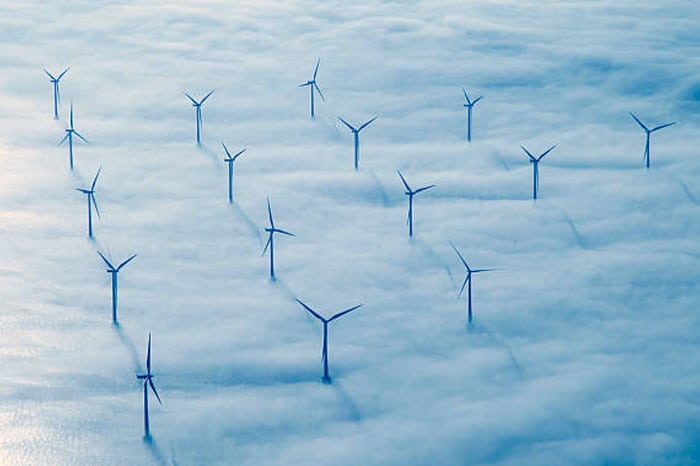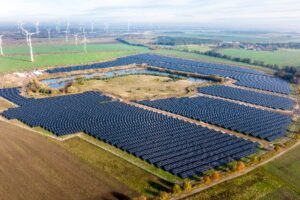What is the Difference Between Horizontal and Vertical Wind Turbines?

Wind energy is becoming an increasingly popular source of renewable energy on planet Earth, with wind turbines being a primary means of harnessing the power of the wind.
There are two main types of wind turbines available today: horizontal axis wind turbines (HAWTs) and vertical axis wind turbines (VAWTs). While both types of turbines work on the same basic principle (they turn the kinetic energy of the wind into rotational energy and then into electrical energy), they have some significant differences in their design, construction, and performance.
Horizontal Axis Wind Turbines
Horizontal Axis Wind Turbines (HAWTs) are a type of wind turbine where the main rotor shaft is horizontal and parallel to the ground. The blades of the turbine are mounted on a rotor, which spins as the wind blows over them. The rotation of the rotor is then transferred to a generator, which produces electricity.
HAWTs are the most commonly used type of wind turbine in the world, with the majority of wind farms using this technology. There are several advantages to using HAWTs over other types of wind turbines, such as Vertical Axis Wind Turbines (VAWTs).
Advantages of Horizontal Axis Wind Turbines
One of the primary advantages of HAWTs is their high efficiency. Since the blades are mounted on a rotating shaft that faces into the wind, they can capture the maximum amount of energy from the wind. Additionally, HAWTs have a high tip speed ratio, which means that the blade tips are moving at a higher speed than the wind speed. This allows them to generate more power than a VAWT of the same size.
Another advantage of HAWTs is their scalability. They can be built in a wide range of sizes, from small residential units to massive offshore wind farms. This makes them a versatile option for a variety of applications, from powering individual homes to generating electricity for entire cities.
Disadvantages of Horizontal Axis Wind Turbines
However, HAWTs also have some drawbacks. They require a tall tower to mount the rotor, which can be expensive to construct and maintain. Additionally, the blades can produce significant noise pollution, which can be a concern for nearby residents.
Vertical Axis Wind Turbines
Vertical axis wind turbines (VAWTs) are a type of wind turbine where the main rotor shaft is set vertically. Unlike horizontal axis wind turbines (HAWTs), which have the blades attached to a horizontal rotor shaft, VAWTs have blades that are attached to a central vertical shaft.
Advantages of Vertical Axis Wind Turbines
One of the primary advantages of VAWTs is their low height requirement. Since the rotor is mounted on a vertical axis, they can be built closer to the ground, which can significantly reduce construction and maintenance costs. Additionally, VAWTs have a smaller footprint than HAWTs, which makes them a better option for urban areas with limited space.

Vertical Axis Wind Turbine, image source: Pixabay
Another advantage of VAWTs is their ability to operate in low wind speeds. Since the rotor blades are always facing the wind, they can generate power even when the wind is not blowing in a consistent direction. This makes them a good option for areas with variable wind patterns.
Disadvantages of Vertical Axis Wind Turbines
However, VAWTs also have some significant drawbacks. They have a lower efficiency compared to HAWTs, due to the fact that the rotor blades are not facing into the wind. Additionally, VAWTs have a lower tip speed ratio, which means that they generate less power than HAWTs of the same size.
Types of Horizontal Axis Wind Turbines
Horizontal Axis Wind Turbines (HAWTs) are the most common type of wind turbine used for generating electricity. These turbines consist of a rotor blade connected to a horizontal axis, which turns a generator to produce electricity. There are several types of HAWTs, including:
Upwind Turbines
In an upwind turbine, the rotor blade is positioned upwind of the tower. This means that the wind hits the blade before it hits the tower, which reduces turbulence and makes the turbine more efficient. Upwind turbines are the most common type of HAWT and are widely used in wind farms.
Downwind Turbines
In a downwind turbine, the rotor blade is positioned downwind of the tower. In this case, the wind hits the tower before hiting the blade, which can cause turbulence and make the turbine less efficient. However, downwind turbines are simpler and cheaper to build than upwind turbines, and they are often used for small-scale applications such as residential wind turbines.
Types of Vertical Axis Wind Turbines
Vertical Axis Wind Turbines (VAWTs) are a type of wind turbine where the main rotor shaft is set vertically, and the blades rotate around it. They have several advantages over traditional Horizontal Axis Wind Turbines (HAWTs), such as being less affected by changes in wind direction, less noisy, and more visually appealing. There are several types of VAWTs, each with its unique features and advantages.
Here are some of the most common types of Vertical Axis Wind Turbines:
Savonius Wind Turbine
The Savonius wind turbine is the oldest type of VAWT, invented in the 1920s. It has a simple design consisting of two or three curved blades that rotate around a vertical axis. The curved blades allow the turbine to start rotating even in low wind conditions, making it ideal for urban areas or low wind speed locations. However, it is less efficient than other types of VAWTs.
Darrieus Wind Turbine
The Darrieus wind turbine is another popular type of VAWT. It consists of two or three airfoils that are shaped like a half-moon and mounted vertically around a central shaft. When the wind blows, the airfoils rotate around the shaft, generating power. Darrieus wind turbines are more efficient than Savonius turbines and can operate in higher wind speeds. However, they require an external power source to start rotating, which makes them less suitable for low wind speed locations.
Giromill Wind Turbine
The Giromill wind turbine is a type of Darrieus turbine with straight blades that are fixed to a rotating vertical axis. The blades are arranged in a helical pattern, and the turbine can rotate in any direction, making it ideal for locations with changing wind direction. Giromill turbines are more efficient than Savonius turbines and can operate in higher wind speeds, but they are less efficient than Darrieus turbines.
H-rotor Wind Turbine
The H-rotor wind turbine is a type of VAWT that resembles the letter “H.” It consists of two vertical blades that rotate around a central shaft. The blades are slightly twisted, which helps to improve efficiency. H-rotor turbines can operate in low wind speed conditions and are more efficient than Savonius turbines, but less efficient than Darrieus turbines.
Vertical Axis Wind Turbine with Archimedes Spiral Blades
This type of VAWT has a unique design consisting of a vertical shaft with Archimedes spiral blades that rotate around it. The Archimedes spiral blades have a double-curved surface that creates a lift force, making the turbine more efficient than other VAWTs. They can operate in low wind speed conditions and can generate power even in turbulent wind conditions.
Conclusion
In conclusion, both horizontal axis wind turbines and vertical axis wind turbines have their advantages and disadvantages. HAWTs are more efficient and scalable, but they require a tall tower and can produce noise pollution. VAWTs are more compact and can operate in low wind speeds, but they have a lower efficiency and generate less power. Ultimately, the choice between the two types of turbines will depend on the specific needs and constraints of each project.






